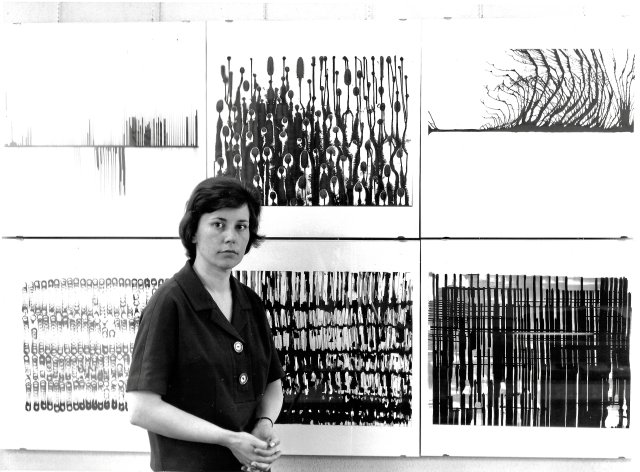Sofie Dawo in the Elitzer Gallery, Saarbrücken 1964
Photo: Institute for Contemporary Art in Saarland, Saarlouis, archive © Julius Schmidt
There is probably no other form of fine art that has been as dominated by female protagonists since the 20th century as textile art. Of course, this was by no means a coincidence: Due to the traditional role assigned to women to take care of the household – including being responsible for sewing, knitting and darning – women inevitably became more close to textile materials and the associated techniques. In addition, the work with fabrics and yarns was also dominated by women in artistic circles; At the beginning of the century, artistically ambitious women sometimes found it difficult to be taught other subjects at art schools.
Last but not least, working with textiles was certainly attractive for many artists because it offered the opportunity to provocatively challenge the assigned roles – as Rosemarie Trockel (*1952) did when she created Playboy Bunnies and others in the 80s Weaving symbols into “wool pictures” – or alienating the universe of domesticity in an uncanny way, such as Louise Bourgeois (1911–2010) with her nightgowns hung on bones and strangely shaped rag dolls.
In recent years, the “Grande Dames” of textile art have seemed to be in demand: at the 2017 Venice Biennale, for example, you could see a landscape made up of gigantic woven balls by Sheila Hicks; Last year, the Berlin gallery Meyer Riegger dedicated a solo exhibition to the American, the first in Germany in 50 years. And the exhibition “The Woven Child,” which brought Louise Bourgeois’s previously neglected textile work into focus, was on display in both Berlin and London.
The Kunsthaus Dahlem, which is currently showing the work of the textile artist Sofie Dawo (1926–2010), is, so to speak, on trend. Curator Petra Gördüren has made it her mission to posthumously associate Dawo, who was relatively unknown during her lifetime and mainly exhibited in the regional context of Saarland, with the ZERO movement and concrete art – which is why, in addition to Dawo’s work, selected works from the 1960s and… 70s by Heinz Mack, Günther Uecker, Erwin Thorn, Nanda Vigo and other representatives of the styles mentioned can be seen. These artists worked with different materials than Dawo, but if you look at glass plates by Nanda Vigo, which are layered in different ways and reflect the light, or a “fire drawing” by Erwin Thorn – the artist burned grid structures onto the paper in series through perforated grids – it becomes clear immediately an aesthetic connection.
Instead of dealing with the role of women, as with Trockel or Bourgeois, Dawo – like the ZERO movement – was mainly concerned with the material itself, with a more fundamental exploration of form and design principles. At the State School for Arts and Crafts in Saarbrücken, she went through the basic teachings based on the Bauhaus, which instructed “how to show the elements of the visible and their relationships in a systematic context.” How are light and shadow, visible and invisible, construction and destruction connected? Dawo addressed these questions using textile means. Destruction as a design principle played a particularly important role for her: she systematically removed threads from carpets, for example, allowing the actually hidden basic fabric to emerge in various ways. In other works, she left unprocessed threads hanging out of carpets or wove bundles of threads into them, thus creating three-dimensional structures that extend into space.
Another artist who is brought together with Dawo in the show, but who belongs to a different generation than everyone else, is Haleh Redjaian, born in Frankfurt am Main in 1971. Like Dawo, she also works with carpets and threads. The installations made of metal frames set up in the middle of the room, on which Redjaian has stretched thin yarn in different colors, are of fragile beauty – different three-dimensional shapes emerge. You can read about the artist that she combines the geometric tradition of Western modernity with Persian ornamentation. It is probably those intercultural approaches that ensure that textile art will continue to be a topic – even if the everyday lives of most women in Western service societies no longer have much to do with sewing, knitting and darning.
»From thread to form. Sofie Dawo’s textile art between ZERO and concretion”, until May 20th, Kunsthaus Dahlem, Berlin
Become a member of the nd.Genossenschaft!

Since January 1, 2022, the »nd« will be published as an independent left-wing newspaper owned by the staff and readers. Be there and support media diversity and visible left-wing positions as a cooperative member. Fill out the membership application now.
More information on www.dasnd.de/genossenschaft
